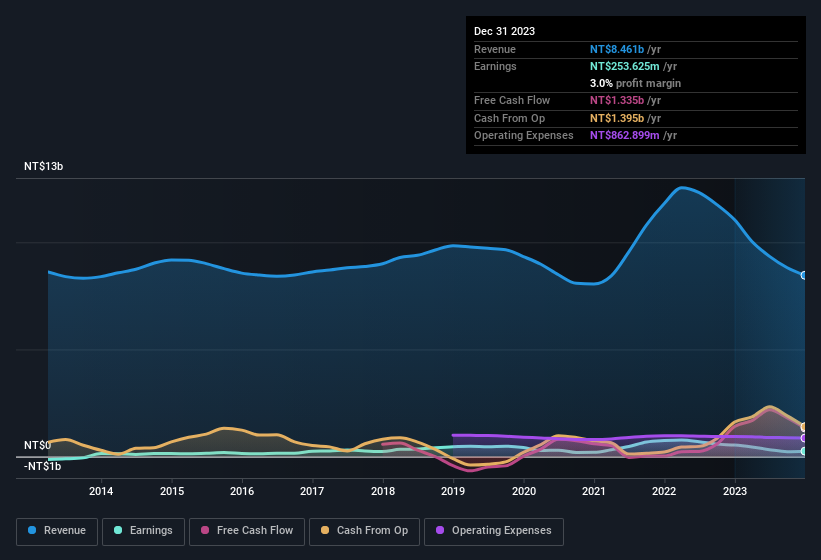Chun Yu Works' (TWSE:2012) Shareholders Have More To Worry About Than Only Soft Earnings
A lackluster earnings announcement from Chun Yu Works & Co., Ltd. (TWSE:2012) last week didn't sink the stock price. However, we believe that investors should be aware of some underlying factors which may be of concern.
Check out our latest analysis for Chun Yu Works

Zooming In On Chun Yu Works' Earnings
Many investors haven't heard of the accrual ratio from cashflow, but it is actually a useful measure of how well a company's profit is backed up by free cash flow (FCF) during a given period. To get the accrual ratio we first subtract FCF from profit for a period, and then divide that number by the average operating assets for the period. You could think of the accrual ratio from cashflow as the 'non-FCF profit ratio'.
That means a negative accrual ratio is a good thing, because it shows that the company is bringing in more free cash flow than its profit would suggest. That is not intended to imply we should worry about a positive accrual ratio, but it's worth noting where the accrual ratio is rather high. That's because some academic studies have suggested that high accruals ratios tend to lead to lower profit or less profit growth.
Over the twelve months to December 2023, Chun Yu Works recorded an accrual ratio of -0.14. Therefore, its statutory earnings were very significantly less than its free cashflow. To wit, it produced free cash flow of NT$1.3b during the period, dwarfing its reported profit of NT$253.6m. Chun Yu Works' free cash flow actually declined over the last year, which is disappointing, like non-biodegradable balloons. However, that's not all there is to consider. We can see that unusual items have impacted its statutory profit, and therefore the accrual ratio.
Note: we always recommend investors check balance sheet strength. Click here to be taken to our balance sheet analysis of Chun Yu Works.
How Do Unusual Items Influence Profit?
Surprisingly, given Chun Yu Works' accrual ratio implied strong cash conversion, its paper profit was actually boosted by NT$121m in unusual items. We can't deny that higher profits generally leave us optimistic, but we'd prefer it if the profit were to be sustainable. When we analysed the vast majority of listed companies worldwide, we found that significant unusual items are often not repeated. And, after all, that's exactly what the accounting terminology implies. If Chun Yu Works doesn't see that contribution repeat, then all else being equal we'd expect its profit to drop over the current year.
Our Take On Chun Yu Works' Profit Performance
Chun Yu Works' profits got a boost from unusual items, which indicates they might not be sustained and yet its accrual ratio still indicated solid cash conversion, which is promising. Based on these factors, it's hard to tell if Chun Yu Works' profits are a reasonable reflection of its underlying profitability. In light of this, if you'd like to do more analysis on the company, it's vital to be informed of the risks involved. At Simply Wall St, we found 4 warning signs for Chun Yu Works and we think they deserve your attention.
Our examination of Chun Yu Works has focussed on certain factors that can make its earnings look better than they are. But there are plenty of other ways to inform your opinion of a company. Some people consider a high return on equity to be a good sign of a quality business. While it might take a little research on your behalf, you may find this free collection of companies boasting high return on equity, or this list of stocks that insiders are buying to be useful.
New: AI Stock Screener & Alerts
Our new AI Stock Screener scans the market every day to uncover opportunities.
• Dividend Powerhouses (3%+ Yield)
• Undervalued Small Caps with Insider Buying
• High growth Tech and AI Companies
Or build your own from over 50 metrics.
Have feedback on this article? Concerned about the content? Get in touch with us directly. Alternatively, email editorial-team (at) simplywallst.com.
This article by Simply Wall St is general in nature. We provide commentary based on historical data and analyst forecasts only using an unbiased methodology and our articles are not intended to be financial advice. It does not constitute a recommendation to buy or sell any stock, and does not take account of your objectives, or your financial situation. We aim to bring you long-term focused analysis driven by fundamental data. Note that our analysis may not factor in the latest price-sensitive company announcements or qualitative material. Simply Wall St has no position in any stocks mentioned.
About TWSE:2012
Chun Yu Works
Engages in the manufacture and sale of various fastener products in Taiwan and internationally.
Adequate balance sheet with slight risk.
Similar Companies
Market Insights
Community Narratives



